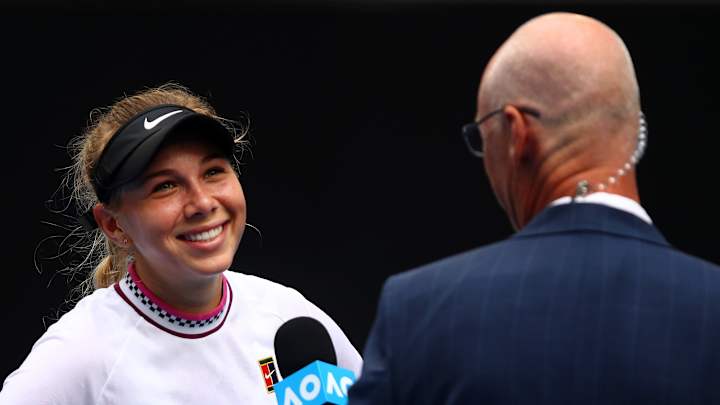Australian Open Midterm Grades: Young Americans, Serena, Federer Get A's

MELBOURNE — The #10YearChallenge has been a pleasant diversion this week here Down Under, as it has Up Over. Novak Djokovic infected us with this. More pleasantly, Belinda Bencic recalled this.
(Plus,minus)- 10 Year Challenge 😅🙈 @rogerfederer #10yearchallenge pic.twitter.com/2lAvyKMNj6
— Belinda Bencic (@BelindaBencic) January 17, 2019
Ten years ago in tennis? In some ways, little has changed since then—Novak Djokovic was the defending Aussie Open champ before Rafael Nadal beat Roger Federer to win the title. (A decade later, they are seeded No. 1, 2 and 3 and are all slicing through the draw with relative ease). Serena Williams won the 2009 Australian Open. A decade later, after three rounds, she is the favorite.
On the other hand, Big Foe—Frances Tiafoe, now in the round of 16—was then Little Foe. Amanda Anisimova was seven years old. There was no Uber, much less Uber Eats.
Ten years from now, we will reflect nostalgically on the 2019 Australian Open. But right now, in the vital present, we present our midterm grades.
A
Remember the Titans: Djokovic, Nadal, Federer, and Serena Williams—74 majors among them—have not been tested. Note that Nadal and Serena are both playing their first tournament since the 2018 U.S. Open and showing no signs of rust.
Maria Sharapova: The taste for battle is still there. Eleven years since winning the title here, her scratch-and-claw takeout of the defending champ, Caroline Wozniacki, was her best match in more than a year.
Ascending Americans: Amanda Anisimova, age 17, didn’t just reached week two; she did so but by soundly outplaying 11th-seeded Aryna Sabalenka, who was the oddsmakers’ third-favorite to win the title. For Frances Tiafoe, beating No. 5 Kevin Anderson was one thing; following that up two days later by beating Andreas Seppi in a grueling five-setter was just as impressive.
Andy Murray: Must have felt like he was attending his own funeral, as player after player—and fan after fan—lined up to voice appreciation for the Brit. He left the door open for a return. But if not, losing his last match to Roberto Bautista Agut in a roller-coaster five-setter is a fitting way to go out.
WERTHEIM: In Andy Murray, Tennis Will Lose One of Its Great Sportsmen
The Lost Generation: Grigor Dimitrov, Milos Raonic, Kei Nishikori, and Tomas Berdych all remain.
American women: As we write this, we have two Williams sisters, Sloane Stephens, Madison Keys and former NCAA champ Danielle Collins are all in the round of 16.
Edwin P. Su, MD: Regardless of whether he attempts to mend Andy Murray, the Hospital for Special Surgery orthopedist got a lot of favorable (and free) publicity last week.
PODCAST: Get to Know Rising American Danielle Collins
B+
Learning experiences: Taylor Fritz (lost to Federer) Alex DeMinaur (Nadal) and Denis Shapovalov (Djokovic) all won a few matches….and then learned how far they still have to go.
B
Stan Wawrinka: Fell in round two to Milos Raonic but played well, and what a good sign that his knee can endure a four-hour assignation.
Eugenie Bouchard: Former top-five player didn’t offer Serena Williams much resistance in round two, but good on her for reviving her game.
Reilly Opelka: Seven-foot American scored a career win over John Isner in round one. Then, in round two, he serves 67 aces—fifth most in history—but loses a winnable second rounder against Thomas Fabbiano.
Sofia Kenin: Young American resides in the top 40 and has announced herself as promising player. But she’ll leave disappointed, having led Halep 4-2 in the third set of her eventual second-round defeat.
C
Tennis politics: The ATP has a brewing Brexit vote—remain with the status quo and retain the current CEO, or leap into a great unknown. The women are getting restless about their second-class citizenship status. The USTA’s CEO position is open and the politicking has begun. The Game of Thrones over the Davis/Laver/Fed/ATP cups is fierce. Bernard Tomic, of all people, calls attention to conflicts of interest. Even for a sport that does uncertainty and division and conflicts of interests like no other, this is a low point.
Jack Sock: The slump has grown legs and a tail. The top American a year ago, he loses to qualifier, Alex Bolt, in round one.
Yulia Putinseva: Players react differently to stress and conflict. And Pootsie is a amous hothead. But you can’t flip off the crowd. (Cameras have phones these days.) https://au.yahoo.com/sports/tennis-brats-shocking-act-disrespect-australian-open-crowd-215740347.html
Starting times: You can’t have players take the court after midnight (as Garbine Muguruza and Jo Konta did last week.) It taxes the tournament employees and isn’t fair to the players.
Aussie dollar: Yes, you can arbitrage this. But for so many players, the prize money increases are offset but a currency that trades on .73 on the dollar.
